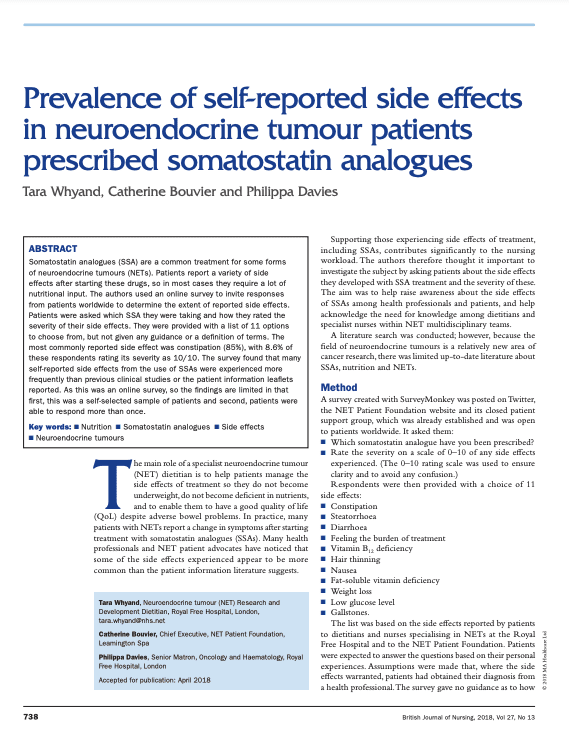NEUROENDOCRINE CANCER TREATMENTS:
SOMATOSTATIN ANALOGUES
Somatostatin Analogues (SSAs) may be used to help control the secretion of hormones if abnormal levels are being produced. SSAs may also be used to slow down growth rate in low to moderate grade ‘well-differentiated’ Neuroendocrine Cancer (NET).
Somatostatin is a substance that occurs naturally in the body. It helps to control the release of hormones into the blood stream – both from cells that should normally release hormones and Neuroendocrine Cancer cells.
- Somatostatin analogues (SSAs) are drugs that mimic the behaviour of somatostatin – so can help control hormone levels.
- SSAs include Octreotide (Sandostatin LAR – made by Novartis and Olutaton – made by TEVA) and Lanreotide (Somatuline Autogel – made by Ipsen).
All 3 are given by injection:
- Octreotide is usually given by a doctor or nurse, whilst Lanreotide can, if you want to, be self-administered.
- There is nurse support for all 3- and all 3 companies have put measures in place to assist with delivery and administration.
Your nurse specialist, specialist team member or pharmacist can give advice on transporting and storing the medicine – and the companies all have a helpline for any further enquiries or information.
Effects of Treatment
Neuroendocrine Cancer Treatments work in a variety of ways – and whilst we wish it wasn’t the case, side-effects can occur – not will occur – but can occur.
Many of these, if they happen, can be mild and manageable – others may cause an alteration or adjustment in treatment, such as reduced dose or interval – occasionally a treatment may have to stop – either temporarily ( a ‘treatment break’) or permanently, because the side-effect is more severe.
You may also be given treatments in a different order to what was first planned or how you may see them given in others – remember – your treatment plan will be personalised to you.
But it is only possible to deal with changes and side-effects, if you are able to talk them through with your specialist nurse or team.
If you notice a change, or don’t feel well, during or after a treatment – it may be tempting to ignore it or not mention it or wait a few weeks to see if things improve. You may be worried that if you do highlight any changes, your treatment may be stopped. However, the sooner your team knows what is happening, the sooner they can help you to deal with any changes – which will not always mean stopping treatment.
Changes or new symptoms may not always be caused by your treatment – Neuroendocrine Cancer itself can cause alterations in health – and other unrelated health issues can also occur. So, it can be helpful to know what to expect from treatment, what to look out for – and, importantly, when and who to contact if changes occur.
SSAs may be used to help control the secretion of hormones if abnormal levels are being produced. SSAs may also be used to slow down growth rate in low to moderate grade ‘well differentiated’ Neuroendocrine Tumours (NETs).
As a SSA starts to be absorbed by the body, it can temporarily upset your usual hormone balance – whether you already have symptoms or not but things can and do settle and improve. When you first start treatment with either Octreotide (Sandostatin LAR or Olutaton) or Lanreotide (Somatuline Autogel) – you will be talked through how it works and what you might expect to happen – including any potential side-effects.
Whether you have already had symptoms before starting this treatment or none at all – developing or worsening symptoms can be alarming.
This is normal – if you are going to experience a change to your ‘normal’- it usually starts within 24 – 48 hours – if you get to about 10 – 14 days without a day or two of these symptoms, then it may not happen. If it does occur – it usually only lasts for 24 – 72 hours – and your specialist team will have advised you on simple steps you can take to manage these symptoms – such as simple pain relief and / or Imodium.
What is not normal is for symptoms to flare up and become constant beyond 3 – 4 days and / or beyond 4 – 5 injections – if this happens let your specialist nurse/team know.
Many people, especially those with Carcinoid Syndrome, find that not only does this temporary reaction stop occurring – but the symptoms they had beforehand also start to improve.
Severe abdominal pain is not a usual occurrence – if this happens – seek medical attention at your nearest hospital- let them know your diagnosis and how and where it’s been treated. It can also be helpful to have your specialist nurse/team contact details with you – if your specialist team is not at the hospital you attend, so that the admitting team can contact them for further information and advice.
The pharmaceutical companies that manufacture somatostatin analogues (which include lanreotide and octreotide) list potential side effects as:
- Loss of appetite – may be further reduced by not eating.
- Feeling and/or being sick – this may be made worse by avoiding food.
- Feeling bloated – often associated with steatorrhoea*, ‘wind’ and / or constipation.
- Stomach pain and/or cramping.
- Diarrhoea – bowel motions may become more frequent and / or fluid.
- Steatorrhoea* – pale, smelly, oily diarrhoea, that doesn’t flush away easily, tending to float in the toilet bowl.
- Soreness or a lump at the injection site.
- Fatigue.
- Blood glucose changes** – this is not the same as developing diabetes. Though if you are diabetic – you may find you need to make some alterations to maintain your usual ‘normal’ blood sugar levels. Ensure your specialist team, dietician and GP are talking to each other as well as you to help maintain diabetic control.
- Gall bladder infection related to thickened bile, bile sludge and / or stones – the function of the gall bladder as a hold and release vessel for bile flow can be affected by SSA, this leads to thickened bile – which can cause irritation and grit or stones to form.
- Reduced thyroid function – just as the pancreas may be affected in its ability to produce hormones, so too, can the thyroid gland be affected.
- Headache and / or dizziness.
- Bradycardia – slowing of the heart rate. Some of the hormones released by Neuroendocrine Cancers can narrow or widen blood vessels and airways – which can lead to flushing, palpitations (rapid heart rate) and wheezing in Carcinoid Syndrome. Altering the levels of these kind of hormones, by SSAs, may result in slowing the heart rate – rather than increasing it.
SSAs can alter the pancreas’ normal response to eating – which is to release certain gut hormones and enzymes to help the body break down and utilise food.
*A lack of pancreatic enzymes (Pancreatic Enzyme Insufficiency – PEI) can result in steatorrhoea occurring.
**An alteration in normal pancreatic based gut hormones being released – can lead to a rise (most common) or fall (less common) in normal blood sugar levels* – especially after eating.
Other changes patients have mentioned include:
- Increased joint discomfort or pain
- Hair thinning or loss (though rarely complete alopecia)
- Vitamin deficiencies – particularly Vitamin A, B (B3 and 12 in particular), D, E & K
- Weight loss or gain.
Prevalence of self-reported side effects in neuroendocrine tumour patients prescribed somatostatin analogues


